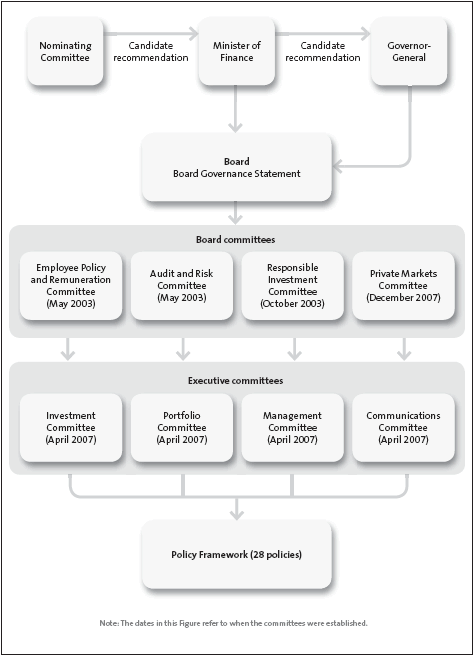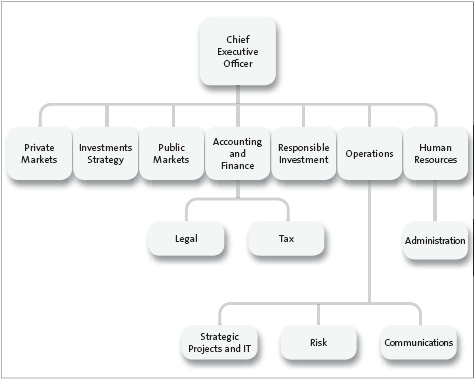Part 2: Background
2.1
New Zealand Superannuation is paid from general taxation raised from the working population.
2.2
One person in eight is over 65 years old, the eligible age to receive a pension. However, by 2030, the ratio of people over 65 is expected to have risen to one in four. This ageing of the population, an issue faced by many developed countries, is the result of a combination of increased life expectancy and lower birth rates.
2.3
The increase in the number of retired people relative to the working age population will lead to a significant increase in the cost of providing New Zealand Superannuation in the medium term. The Guardians’ website says the net annual cost of superannuation is expected to rise from 3.4% of Gross Domestic Product (GDP) to about 5.6% by 2030, and to about 6.9% by 2050.1
2.4
In this Part, we outline:
- the role of the Fund;
- the role of the Guardians; and
- the Guardians’ governance, management, and business operating structures.
Role of the New Zealand Superannuation Fund
2.5
Moving to a partially pre-funded superannuation system is an alternative to completely relying on the “pay-as-you-go” system, where payments in a given period are made from the tax revenue collected in the same period. A partially pre-funded superannuation system has been created through the Fund.
2.6
The role of the Fund is to build up a portfolio of Crown-owned assets while the cost of New Zealand Superannuation remains relatively low. Those assets will then be progressively drawn on to supplement the Crown’s annual budget to meet the expected higher ongoing costs of New Zealand Superannuation.
2.7
The Fund was established in 2001 and is operated independently of the Government. It has a clear mandate set out in the Act that is sufficiently broad to ensure that all investment decisions are separate from the Government, while also meeting the Government’s long-term objectives for the Fund. The Fund is expected to be a permanent part of the Government’s balance sheet into the 22nd Century.
2.8
In September 2003, the Fund received an initial contribution of $2.5 billion from the Crown. Thereafter, the Fund received fortnightly contributions from the Crown based on an annual contribution schedule. The annual contribution schedule is determined and calculated by the Treasury, and sets out the timing and amount of each fortnightly payment from the Crown to the Fund. The cumulative amount in any given year represents the annual Crown contribution, which to date has been about $2 billion a year. The Guardians reinvest all investment returns into the Fund on a long-term basis.
2.9
The Act prohibits capital withdrawals from the Fund before 1 July 2020. Capital contributions are made fortnightly by the Crown from general taxes and are projected to stop around 2028, at which time the Crown will start to make capital withdrawals from the Fund.
2.10
The Fund is projected to be a net contributor to New Zealand Superannuation from 2022, when tax paid by the Fund to the Crown is expected to exceed the Crown’s capital contribution to the Fund. The Fund’s assets are projected to peak at about 36% of GDP in 2037, and then gradually fall as a proportion of GDP.
Role of the Guardians of New Zealand Superannuation
2.11
The Act established the Guardians as a separate Crown entity responsible for managing and administering the Fund and its ongoing investment activities.
Investing requirements and restrictions
2.12
Section 58(2) of the Act provides that the Guardians:
... must invest the Fund on a prudent, commercial basis and, in doing so, must manage and administer the Fund in a manner consistent with -
(a) best-practice portfolio management; and
(b) maximising return without undue risk to the Fund as a whole; and
(c) avoiding prejudice to New Zealand’s reputation as a responsible member of the world community.
2.13
The Act also sets certain requirements for the Guardians to fulfil while managing and administering the Fund. These include:
- restrictions on controlling interests;
- establishment and content of investment policies, standards, and procedures;
- the use of Investment Managers;
- appointing a Custodian; and
- responding to any directions given by the Minister.2
2.14
Most of the day-to-day operations of the Fund are outsourced to Investment Managers working through an external Custodian. The Custodian has a major role holding and settling investments on behalf of the Guardians, and monitoring the investment activities of the Investment Managers appointed by the Guardians.
Governance structure
2.15
The Guardians have a Board of seven members and a management team headed by a Chief Executive Officer.
Appointment of the Board of the Guardians of New Zealand Superannuation
2.16
The Board is responsible for governance and overseeing management of the Fund. The appointment of Board members is subject to section 56 of the Act. This section requires the Minister of Finance (the Minister) to establish a nominating committee external to the Board and the Fund. The committee recommends candidates to the Minister, who then consults about the nominations with representatives of political parties in Parliament. The Minister then recommends Board appointments to the Governor-General.
Governance Framework
2.17
The Board adopted a corporate governance framework for the Fund (the Governance Framework) that is consistent with most commercial organisations. The Governance Framework is subject to the governance structures required by the Act and those determined necessary by the Board.
2.18
Figure 1 outlines the Governance Framework, including the committees that oversee the Guardians’ activities. There are four Board committees (see paragraph 3.11) and four executive committees (see paragraph 3.13).
Figure 1
Governance framework for the Guardians of New Zealand Superannuation at the time of our audit

Note: The dates in this Figure refer to when the committees were established.
Organisational structure
2.19
The Guardians’ staff are divided into teams, reporting through managers to executive management. Figure 2 shows the organisational structure at team level at the time of our audit.
Figure 2
Organisational structure for the Guardians of New Zealand Superannuation at the time of our audit

Business operating structure
Use of outsourcing
2.20
The Guardians chose to outsource the management of the Fund’s asset portfolio. This was so they could obtain the skills to deal with the diversity of the asset classes and the specialised objectives within each asset class under the Guardians’ investment strategy.
2.21
The Guardians’ outsourcing business operating model allows them to hold significant and diverse international investments, and to apply specialist techniques designed to expose the Fund to growth elements within individual asset classes.
Role of Investment Managers
2.22
Specialist skills are obtained by outsourcing investment management to Investment Managers. An Investment Manager is a firm or person appointed by the Board to manage and invest a portfolio of investments for the Guardians subject to an agreed investment mandate. Some Investment Managers have more than one investment mandate.
2.23
The role of Investment Managers is to conduct investment activity on behalf of the Fund, subject to terms agreed in the investment mandate. The use of Investment Managers gives the Fund access to expert systems, research, and investment techniques.
Role of the Custodian
2.24
Having external Investment Managers also means there is a strong business case for outsourcing custodial activities and investment administration processes to specialists. Consequently, the Guardians have outsourced custodial and investment administration.
2.25
The role of the Custodian is to manage the day-to-day transaction processing, settlement, ownership registration of the various investments, reporting of the Fund, and investment mandate performance.
Operating functions carried out in-house
2.26
The combined effect of outsourcing investment management and the custodial and administration processes means that very few of the Fund’s day-to-day operating functions are retained in-house by the Guardians.
2.27
The remaining operating functions, which continue to be carried out in-house, include:
- investment strategy, analysis, and long-term forecasting;
- reporting to stakeholders;
- managing external providers;
- identifying and selecting Investment Managers;
- monitoring and managing the performance of Investment Managers;
- funding and liquidity management;
- financial administration of the Guardians; and
- administering processes for responsible investment.
1: We acknowledge the New Zealand Superannuation Fund website www.nzsuperfund.co.nz as the source of some of this background information.
2: While accountable to the Crown, the Guardians operate at arm’s length from the Crown. Under the Act, the Minister of Finance may give directions to the Guardians regarding the Government’s expectations as to the Fund’s performance, but must not give any direction that is inconsistent with the duty to invest the Fund on a prudent and commercial basis. The Guardians must have regard to any direction from the Minister. Any direction given by the Minister must be tabled in Parliament. (Source: www.nzsuperfund.co.nz)
page top
